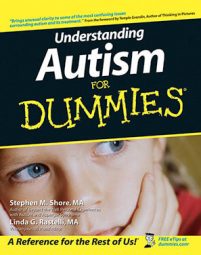One of the hardest things to understand about an autism spectrum disorder is the great importance many people with autism place on structure and routine. Your autistic child may shriek if she can’t watch her favorite video all the way through each time, even though she’s seen it countless times. Or he may have to put on his shoes immediately after he puts on his socks, and if his parents can’t locate the shoes he likes best immediately, he asks for them repeatedly, sounding like a broken record, until he gets them.
Dealing with the symptoms of autism isn’t easy, and dealing with others’ negative reactions just adds to the struggle. A person with autism may be battling feelings of chaos and anxiety. His world may be a confusing jumble of unrelated events, loud and painful sounds, or overly bright lights, like being in a funhouse where the entire environment is distorted.
In such a situation, the person feels the need to impose an order on the world just to survive and have a feeling of security. Not understanding or processing information from his senses and brain the way that others do, the person creates his own security. Nobody wants the feeling of security ripped away — particularly if you don’t know why it’s happening. You may not understand such behavior (and you don’t have to), but you can help by maintaining routines and helping the child deal with new and unfamiliar routines.
Advocates for autism believe that non-autistic people have caused harm by arbitrarily imposing their judgments about what’s acceptable behavior on people with autism. For the person with autism, his behavior serves a need and seems right and logical to him — what he’s doing isn’t irrational.
It’s important to know the difference between an autistic person’s involuntary responses and behaviors, and actions that are authentic reflections of who the person is. You want to help the person get past the former; you want to encourage the latter. Automatic behaviors may vary across the autism spectrum. High-functioning individuals may exhibit an intense need to organize or learn intricate detail about everyday items, whereas low-functioning individuals may be resistant to physical change around them, such as chairs being moved around rooms.
One global mantra you can keep to reduce the chance of sensory overload when you attempt to introduce different routines is to keep things simple. Slow down the pace of your instruction, and simplify the information you give. Your child may have trouble attaching meaning to words you say, so give him time to make connections, and don’t ever raise your voice.
The following list gives you some more tips for different situations:
People with autism may fixate on certain activities, words, songs, or objects. The fixation isn’t a random, senseless act, but an attempt to compensate or adapt to their inability to effectively connect meaning to others’ words or actions.
You should attempt to channel these fixations constructively, but above all, you should meet these constructions with an attempt at understanding, not shame and criticism.
Try to introduce new things, people, or places gradually by talking about them first. You can “walk through” a visit to the dentist before it happens to identify people and items or to “watch” another person’s (mom, sibling) exam. You can also use pictures or other graphics to represent the new experience. Do the things you’d normally do to comfort a typical child, only do more of them. The familiar is comforting, and people with autism need more comfort for their jangled nerves.
Be sure to repeat simple questions you pose and remain patient. Many people with autism have slowed processing speeds (as slow as 8 to 10 seconds from hearing a request to the beginning of a response), so you shouldn’t expect immediate responses. Many people with autism also have trouble accessing their long-term memories; they can store the information they learn, but they can’t recall facts in new situations when needed. Use simple, concrete, stripped-down language when giving directions without introducing extra information that can slow down the processing of a person with autism.
Try to teach new information to your child — even social skills, which Asperger children need help with — through scripts or “social stories”, or other social narrative techniques that break down a process into easily remembered steps. For example, you can break down the process of getting ready in the morning into a series of steps, beginning with brushing your teeth and washing your face and ending with putting on your coat.
The autistic person can learn steps much easier if he or she can see them in pictures. Books are available with illustrated scripts for many common activities, or you can create your own social stories at home.

